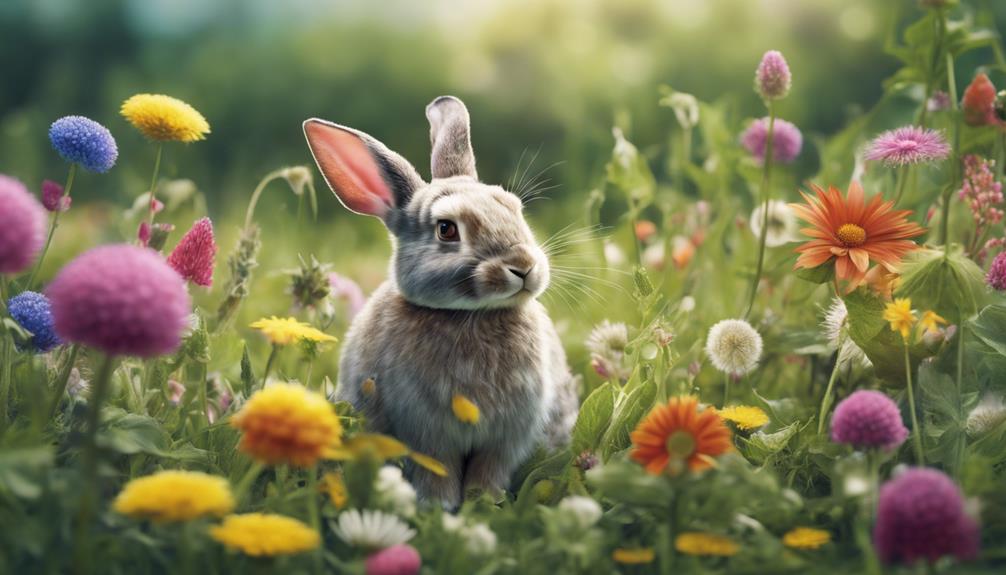You can forage for wild and garden plants like dandelion greens, clover, and plantain leaves to provide your rabbits with a nutritious and varied diet. These plants mimic their wild ancestors' diet, promoting mental stimulation, dental health, and essential nutrients. Incorporating fresh forage can stimulate natural behaviors and provide a diverse range of nutrients. From hay choices like timothy and alfalfa to edible flowers and fresh greens, there are many options to explore. By incorporating a variety of forage options, you can create a healthy and engaging diet for your rabbits – and there's even more to discover.
Key Takeaways
- Forage for wild and garden plants rich in essential nutrients, mimicking rabbits' wild ancestors' diet for mental stimulation and diverse nutrition.
- Dandelion greens, clover, and plantain leaves are safe and nutritious forage options for rabbits.
- Offer fresh herbs like chamomile, mint, and dandelion root to support gut health, digestion, and relaxation.
- Incorporate edible flowers like calendula, hibiscus, and rose petals for added nutrition and variety.
- Provide sticks, roots, and flowers like willow, apple, and dandelion root for natural chewing opportunities and dietary diversity.
Fresh Vegetation for Rabbits
When it comes to providing fresh vegetation for your rabbits, you'll want to focus on a variety of wild and garden plants rich in essential nutrients. Rabbits thrive on a natural diet that mimics their wild ancestors', and foraging for fresh vegetation can provide a more diverse and stimulating diet compared to commercial pellets.
Fresh vegetables and plants offer numerous benefits, including mental stimulation and dental health. To guarantee safe foraging, introduce new plants gradually to monitor for sensitivities or digestive issues. Some safe options for fresh vegetation include dandelion greens, clover, and plantain leaves. These plants aren't only nutritious but also easy to forage and incorporate into your rabbit's diet.
Hay Options for Rabbits

As you explore the world of hay options for your rabbit, you'll likely come across Timothy Hay, a staple in many a rabbit's diet.
But you may also want to explore other options, like Alfalfa Hay, which offers unique benefits, or Oat Hay, an alternative worth exploring.
Timothy Hay Quality
You'll want to choose a high-quality timothy hay that's free from dust, mold, and excessive stems, as it will have a significant impact on your rabbit's overall health and digestion.
Timothy hay is a high-fiber option that aids in digestion and dental health for rabbits. When selecting timothy hay, look for a product that's fresh, green, and has a sweet smell. Avoid hay with mold, dust, or excessive stems, as these can cause respiratory problems and digestive issues in your rabbit.
A high-quality timothy hay is essential for maintaining your rabbit's digestive health. The high-fiber content helps to keep their digestive system regular and prevents health problems like constipation and diarrhea.
Additionally, timothy hay helps to promote good dental health by encouraging natural chewing behavior and wearing down their teeth. By providing your rabbit with a high-quality timothy hay, you'll be supporting their overall health and well-being.
Alfalfa Hay Benefits
While timothy hay is an excellent choice for adult rabbits, alfalfa hay offers unique benefits that make it an ideal option for specific life stages, particularly young, growing rabbits and pregnant or nursing does.
As you consider the best hay options for your rabbit, it's crucial to understand the benefits of alfalfa hay. This type of hay is high in protein, making it suitable for young, growing rabbits that require extra nutrition for development. Additionally, alfalfa hay is rich in calcium, which is beneficial for rabbits' bone health and development.
However, it's not recommended for adult rabbits due to its high protein and calcium content, which can lead to health issues. Instead, adult rabbits may benefit more from grass hays like timothy or meadow hay for their daily diet.
Offering a mix of alfalfa hay and grass hay can provide a balanced diet for rabbits at different life stages. By understanding the benefits of alfalfa hay, you can make informed decisions about your rabbit's diet and make sure they receive the nutrients they need to thrive.
Oat Hay Alternatives
If you're looking for a change or can't find oat hay, there are several alternatives to explore. Timothy hay is a popular choice, high in fiber and suitable for all life stages of rabbits.
Orchard grass, on the other hand, offers a softer texture compared to timothy hay, making it a great option for picky eaters.
Meadow hay provides a diverse mix of grasses and herbs, giving your rabbit a varied diet.
Alternatively, you can opt for botanical hay blends that combine different herbs like chamomile, mint, and dandelion to add flavor and nutrients to their diet.
When choosing an oat hay alternative, take into account your rabbit's individual needs and preferences.
Grass hay, like meadow hay, can provide a natural and nutritious option.
Ultimately, the key is to find a hay that your rabbit enjoys and that meets their nutritional needs.
Dried Herbs for Rabbit Health

As you explore dried herbs for your rabbit's health, you'll want to examine two key areas: calming herbal blends and digestive health tonics. These specific types of dried herbs can greatly benefit your rabbit's overall well-being, and understanding their unique benefits will help you make informed choices.
Calming Herbal Blends
By incorporating calming herbal blends, such as chamomile and mint, into your rabbit's diet, you can provide a natural way to promote relaxation and improve overall health. These dried herbal blends not only add variety to your rabbit's diet but also aid in digestion and overall health.
Here are some benefits of incorporating calming herbal blends into your rabbit's diet:
- Promotes relaxation: Chamomile and mint have soothing properties that can help calm your rabbit.
- Aids digestion: Mint can freshen breath and aid in digestion, while chamomile can soothe digestive issues.
- Provides mental stimulation: Including dried herbs in your rabbit's diet can promote mental stimulation and relaxation.
- Natural and safe: Herbal blends offer a natural and safe way to enhance your rabbit's diet with beneficial compounds.
Digestive Health Tonics
Incorporating digestive health tonics made from dried herbs like chamomile, peppermint, meadowsweet, and marshmallow into your rabbit's diet can provide a natural and effective way to promote a healthy gut flora balance and prevent gastrointestinal issues.
These herbs have been known to aid in digestion and soothe the digestive system, reducing the risk of gastrointestinal problems in rabbits. Dandelion root and nettle leaf are also beneficial in supporting overall digestive health.
By adding these herbs to your rabbit's diet, you can create a balanced gut flora, which is essential for their overall well-being.
Digestive health tonics made from dried herbs are a natural and effective way to maintain your rabbit's digestive health. They can be used to prevent and alleviate digestive issues, ensuring your rabbit leads a healthy and happy life.
Edible Flowers for Rabbits

You can add a pop of color and a boost of beneficial compounds to your rabbit's diet with edible flowers like calendula and hibiscus. These flowers provide a fresh and natural way to meet your rabbit's nutritional needs. By incorporating edible flowers into their diet, you can create a more varied and interesting fresh food experience for your rabbit. This not only adds flavor and aroma but also provides essential vitamins and minerals.
Here are some edible flowers you can consider adding to your rabbit's diet:
- Calendula: Rich in antioxidants and vitamins A and E, calendula flowers provide a boost of beneficial compounds.
- Hibiscus: High in vitamins and minerals, hibiscus flowers add a pop of color and flavor to your rabbit's diet.
- Rose petals: Adding a romantic touch to your rabbit's diet, rose petals provide a natural and fragrant option.
- Dandelion: With their bright yellow petals, dandelion flowers offer a natural and nutritious option for your rabbit.
Best Fresh Greens for Rabbits

Fresh greens like dandelion, parsley, and cilantro are essential to your rabbit's diet, providing a rich source of vitamins and minerals that support their overall health. These wild leaves are packed with nutrients that are good for rabbits, making them a great addition to their diet. You can forage for these greens in the wild, but make sure to identify them correctly to avoid any harmful lookalikes.
In addition to these greens, leafy vegetables like kale, arugula, and romaine lettuce are also excellent options. They provide essential nutrients and hydration for your rabbit, making them a great way to keep them healthy and happy.
Herbs like basil, mint, and oregano are also great options, adding flavor to your rabbit's diet while offering digestive benefits. By incorporating these fresh greens into your rabbit's diet, you can ensure they're getting the nutrients they need to thrive.
Mixing It up for Variety

What's the best way to keep your rabbit engaged with their diet, while ensuring they get the nutrients they need to thrive? The answer lies in mixing it up with a variety of forage options. By providing a range of safe and nutritious choices, you can mimic a more natural diet for your rabbit, promoting overall health and well-being.
Here are just a few ways mixing it up can benefit your rabbit:
- Different nutrients: Each forage option offers distinct nutrients, ensuring your rabbit gets a balanced diet.
- Natural foraging behaviors: A diverse range of forage encourages rabbits to exhibit natural foraging behaviors, enriching their environment.
- Preventing dietary boredom: Introducing a mix of safe and nutritious forage options can help prevent dietary boredom and keep your rabbit engaged.
- Mimicking a natural diet: Variety in foraging options can help recreate a natural diet for your rabbit, meeting their dietary needs and promoting overall health.
Sticks and Roots for Rabbits

As you continue to mix up your rabbit's diet, incorporating sticks and roots can add a new dimension of nutrition and entertainment to their foraging experience. Sticks like willow and apple offer natural chewing opportunities for rabbits, which can help keep their teeth trimmed and healthy.
When it comes to roots, you can introduce dried dandelion root, rich in vitamins, minerals, and fiber, making it a nutritious snack for your rabbit. Root vegetables like carrots and parsnips can be foraged and enjoyed by rabbits, providing a crunchy and tasty treat. In addition to these options, you can also provide natural chewing opportunities with chervil, parsley, and dill stalks.
To add some fragrance and interest to their diet, introduce edible flowers like rose petals. Remember to always introduce new foods gradually to prevent digestive upset. By incorporating sticks and roots into your rabbit's diet, you'll be providing a varied and engaging foraging experience that will keep them happy and healthy.
Frequently Asked Questions
What Is the Best Forage for Rabbits?
You're wondering what's the best forage for your rabbit, and the answer is fresh greens like dandelion, high-fibre hays, and specially formulated blends that provide essential vitamins and minerals for peak health and digestion. It’s also important to offer a variety of textures and flavors to keep your rabbit interested and stimulated. In addition to these staples, foraging treats for my rabbit, such as small amounts of fruits or herbs, can add diversity to their diet and make mealtime more engaging. Always ensure that any additional treats are given in moderation to avoid any disruptions to their digestive system.
What Food Is Safe for Wild Rabbits?
When it comes to feeding wild rabbits, you'll want to stick to safe options like timothy, orchard grass, and dandelion, steering clear of toxic plants like avocado and ivy to guarantee their health and wellbeing.
What Is a List of Bunny Safe Food?
As you begin a culinary adventure for your furry friend, you'll discover a treasure trove of bunny-safe delights, including timothy hay, meadow hay, dried mint, and chamomile, which will delight your rabbit's taste buds and nourish their body.
What Do You Feed Rabbits When Foraging?
When foraging for your rabbit, you feed them fresh greens, herbs, and flowers like dandelion, mint, and calendula, as well as safe tree branches, introducing them gradually to prevent digestive issues.
Conclusion
As you forage for your rabbit, remember that variety is key. Providing a mix of fresh vegetation, hay, dried herbs, edible flowers, and sticks can guarantee a balanced diet.
Research suggests that rabbits thrive on diverse, nutrient-rich food sources, supporting the theory that a varied diet can reduce the risk of digestive issues.
By incorporating these options, you'll be giving your rabbit the best chance at a happy, healthy life.










